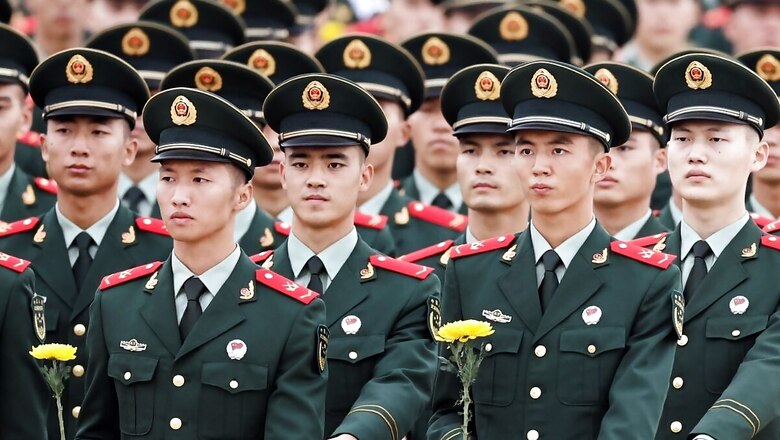
views
On April 19, 2024, Chinese President Xi Jinping unveiled the new Information Support Force (ISF) in the Bayi Building. In addition to giving the ISF the military flag, Jinping gave a speech. The Central Military Commission (CMC), the People’s Liberation Army’s highest decision-making body, is directly in charge of the recently established ISF. ISF is an upgraded or modified Strategic Support Force (SSF) version. The SSF was set up by the January 1, 2016, announcements of the National Defence Modernization Programme and the reforms in the PLA’s current armed forces formations. The SSF supervises the PLA’s space and cyber capabilities.
Xi Jinping undertook his more extensive national defence modernisation programme in 2015 by establishing the SSF, which is now the ISF. Since then, the PLA has undergone operational and structural changes. By 2027, the PLA will celebrate the anniversary of its creation, and it has announced its centenary goals and outcomes. The 14th Five-Year Plan (2021–2026) of the People’s Republic of China (PRC) was revealed by the state council with a particular emphasis on military modernisation.
Modern Warfare and Logic of Information Intelligence
In modern warfare, autonomous networks with “software-defined communications” capabilities are made possible by current digital and electronic networks. Massive quantities of data are needed to bleed down to the core intelligence, and in the PRC, that entailed maintaining a robust and independent body beneath the top decision-making body. To facilitate collaborative intelligence gathering by other military forces units and intelligence organisations, such as the Ministry of State Security and the Ministry of Public Security, the command under the highest body (CMC) will offer universal application. This is an attempt to obtain faster, best intelligence to respond to the enemy more quickly, either before, during, or after the war.
This newly created unit’s specific objectives and operational know-how still need to be unveiled. However, Xi Jinping and other officials, such as Li Wei, the political commissar, and Bi Yi, the commander of the ISF, have laid out the force’s fundamental goals and operational capabilities in their speeches. The director and spokesperson for the Ministry of National Defense’s Information Bureau contended in the press conference that “the PLA now has a new system of services and arms under the leadership and command of the CMC.”
There are four arms: the Joint Logistic Support Force, the Cyberspace Force, the Information Support Force, and the Aerospace Force. There are also four services: the army, navy, air force, and rocket force.
Further, at the press conference; emphasis was placed on modernising China’s national defence. The reason for building this new institution within the armed forces structures is “to build a strong military, and a strategic step to establish a new system of services and arms and improve the modern military force structure with Chinese characteristics. The Information Support Force is a brand-new strategic arm of the PLA and a key underpinning of coordinated development and application of the network information system. It plays an important role and promotes high-quality development and the ability to fight and win in modern warfare”.
Xi emphasised that the information support force, according to Xinhua, will play a pivotal role in enhancing the Chinese military’s superior advancement and competitiveness in contemporary conflict. Xi said that the force “should integrate deeply into the joint operation system of the Chinese military, carry out information support operations precisely and effectively, and facilitate military operations in various directions and fields.” In addition, he called for creating a network information system that satisfies the needs of contemporary fighting, incorporates traits of the Chinese military, and expedites the development of integrated combat capabilities.
Which factors are behind this change in direction? The long-term objectives of the armed forces restructuring that started in late 2015 and early 2016 are to challenge the dominant position of the current military powers. Since then, the globe has witnessed two biggest battles, including regional and large nations like Israel and Russia. When it comes to determining the armies’ operational capability in both conflicts and wars, intelligence has been the most critical factor. Since then, there have been significant changes to the fighting in both regions. Consequently, given the PRC’s determination to seize Taiwan as soon as possible, the Chinese leadership has acknowledged that it needs to rearrange its critical war capabilities.
Conclusion
In summary, since Xi took the leadership position, restructuring China’s armed forces has remoulded and modified its existing war-fighting units. Old structures were either destroyed or altered, or Xi created new units in what the CPC has called a ‘new era’. The diversified interests and more comprehensive outlook have allowed their leadership to take bold steps in making the PLA a world-class army that could fight and win the war. The creation of the ISF can contribute to its larger share since war is a multi-front activity, and intelligence gathering is one of the topmost priorities of modern armies. The ultimate aim of this institution is to apply Sun Tzu’s maxim ‘winning a war without fighting a war’.
The author is a PhD candidate in the Chinese division of the Centre for East Asian Studies (CEAS), Jawaharlal Nehru University, New Delhi. Views expressed in the above piece are personal and solely those of the author. They do not necessarily reflect News18’s views.



















Comments
0 comment